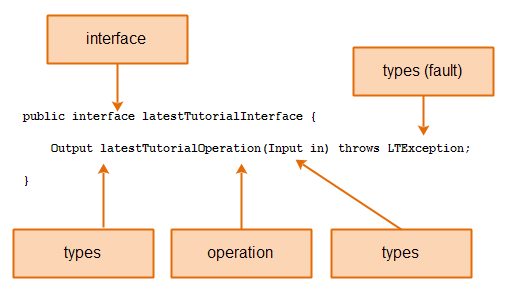WSDL 2.0 - Overview
Jakob Jenkov |
A WSDL file is an XML file describing the interface of a web service. A WSDL 2.0 file contains the following elements:
description |
The description element is the root element of the WSDL 2.0 file.
All other WSDL elements are nested inside this element. |
types |
The types element contains a specification of the data types exchanged between the client and the web service.
By default these data types are described using XML Schema.
|
interface |
The interface element describes what operations the web service has, and what messages
are exchanged for each operation (input / output). It also describes possible fault messages.
|
binding |
The binding element describes how the web service is accessed over the network.
Typically the binding element binds the web service to the HTTP protocol.
|
service |
The service element describes where the web service can be accessed on the network.
Typically the service element contains a URL to the service.
|
documentation |
The documentation element is optional and may contain a humanly readable description
of the web service.
|
import |
The import element is optional and may be used to import XML Schemas or other WSDL
files.
|
Each of these elements are explained in more detail in their own texts. See the top corner of this page for links to these texts.
Here is an outline of the required XML elements in a WSDL file:
<description> <types> </types> <interface> </interface> <binding> </binding> <service> </service> </description>
WSDL Compared to Java Interfaces
Since WSDL describes the interface of a web service, I thought it might be useful for you to see how the XML elements in the WSDL match the declaration of a Java interface. That is what the diagram below shows. The orange boxes represent elements in the WSDL file.
 |
| WSDL compared to a Java interface. The orange boxes are WSDL elements. |
As you can see, the Java classes (Input and Output) would be defined in the types element in WSDL.
So would the exception. The method in the Java interface would be declared in an operation element
inside the WSDL interface element. You'll see more examples on that in the interface
text.
Full WSDL Example
Here is a full WSDL example:
<?xml version="1.0" encoding="utf-8" ?>
<description
xmlns= "http://www.w3.org/ns/wsdl"
targetNamespace= "http://jenkov.com/MyService"
xmlns:tns= "http://jenkov.com/MyService"
xmlns:stns = "http://jenkov.com/MyService/schema"
xmlns:wsoap= "http://www.w3.org/ns/wsdl/soap"
xmlns:soap= "http://www.w3.org/2003/05/soap-envelope"
xmlns:wsdlx= "http://www.w3.org/ns/wsdl-extensions" >
<documentation>
This is the web service documentation.
</documentation>
<types>
<xs:schema
xmlns:xs= "http://www.w3.org/2001/XMLSchema"
targetNamespace= "http://jenkov.com/MyService/schema"
xmlns= "http://jenkov.com/MyService/schema">
<xs:element name="latestTutorialRequest"
type="typeLatestTutorialRequest"/>
<xs:complexType name="typeLatestTutorialRequest">
<xs:sequence>
<xs:element name="date" type="xs:date"/>
</xs:sequence>
</xs:complexType>
<xs:element name="latestTutorialResponse" type="xs:string"/>
<xs:element name="invalidDateError" type="xs:string"/>
</xs:schema>
</types>
<interface name = "latestTutorialInterface" >
<fault name = "invalidDateFault" element = "stns:invalidDateError"/>
<operation name="latestTutorialOperation"
pattern="http://www.w3.org/ns/wsdl/in-out"
style="http://www.w3.org/ns/wsdl/style/iri"
wsdlx:safe = "true">
<input messageLabel="In" element="stns:latestTutorialRequest" />
<output messageLabel="Out" element="stns:latestTutorialResponse" />
<outfault messageLabel="Out" ref ="tns:invalidDateFault" />
</operation>
</interface>
<binding name="latestTutorialSOAPBinding"
interface="tns:latestTutorialInterface"
type="http://www.w3.org/ns/wsdl/soap"
wsoap:protocol="http://www.w3.org/2003/05/soap/bindings/HTTP/">
<fault ref="tns:invalidDateFault" wsoap:code="soap:Sender"/>
<operation ref="tns:latestTutorialOperation"
wsoap:mep="http://www.w3.org/2003/05/soap/mep/soap-response"/>
</binding>
<service
name ="latestTutorialService"
interface="tns:latestTutorialInterface">
<endpoint name ="latestTutorialEndpoint"
binding ="tns:latestTutorialSOAPBinding"
address ="http://jenkov.com/latestTutorial"/>
</service>
</description>
| Tweet | |
Jakob Jenkov | |











